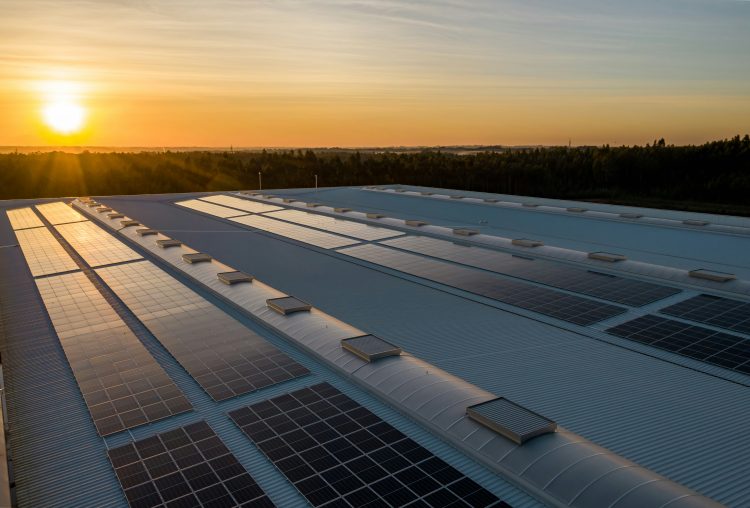In the midst of an urgent climate crisis, the corporate world stands at a pivotal juncture. The top 100 companies are responsible for 71% of global greenhouse gas emissions, squarely placing the onus for change on corporations. Scope 2 emissions, which often constitute more than half of a company’s total carbon footprint, expose businesses to various risks, including rising energy prices, regulatory sanctions, potential carbon taxes, and reputational damage among eco-conscious consumers.
Amidst this challenging landscape renewable energy (RE) offers a clear and scalable path forward. By strategically weaving solar, wind, and other RE sources into their energy mix, corporations have the power to dramatically slash their Scope 2 emissions. This proactive approach not only minimises environmental impact but also unlocks several financial benefits, including increased energy independence, and lower electricity costs compared to grid-based electricity tariffs.
The Scope 2 imperative and the RE-volution
Scope 2 emissions are indirect emissions from purchased electricity, heat, or steam used by a reporting company, which can be reduced through energy conservation, efficiency upgrades, and transitioning to low-carbon electricity sources. Companies can achieve Scope 2 decarbonisation through operational efficiencies, resource conservation, and adopting energy-efficient machinery and processes. Additionally, investing in Renewable Energy Certificates (RECs) or International Renewable Energy Certificates (I-RECs) offers the dual benefit of reducing emissions and supporting renewable energy development globally.
The global energy landscape is shifting towards cleaner and more sustainable sources. The adoption of renewable energy is driven by declining technology costs, robust government support, and heightened public awareness of climate change. In 2023, G7 countries collectively added 69.4 GW of renewables, marking a 7.6% increase from 2022, while G20 nations reached 3084 GW, growing by 15.0%. Despite this progress, it still falls short of the trajectory needed to limit global warming to 1.5°C. IRENA’s analysis indicates a widening gap between current progress and the 1.5°C pathway, with the projected emissions gap in 2050 increasing to 16 gigatonnes.
Crossing this chasm necessitates a rapid expansion of renewable energy assets, electrification, and efficiency improvements across sectors to meet critical 2030 and 2050 emissions targets.
Pathways to Reduce Scope 2 Emissions
Corporations can take several approaches to reduce their Scope 2 emissions, namely:
- Energy Efficiency (EE) and Operational Efficiency: Energy efficiency is the ability to use the least amount of energy resources possible to get the best results in any activity. It means using less energy to perform the same task or produce the same result, and in the process, cutting energy bills and reducing pollution. Improving energy efficiency in operations and facilities plays a pivotal role in Scope 2 emissions pathways. By the year 2030, the adoption of energy efficiency enhancements in buildings and industry can reduce energy consumption by up to 30%. Further, operational efficiency improvements can result in a reduction of energy consumption by an additional 20-40%.
- Renewable Energy (RE): Transitioning to RE sources such as solar or wind power is at the heart of Scope 2 emissions reduction. Evidence suggests that there is a need to reduce energy-related global CO2 emissions by 70% by 2050 to necessary to meet climate goals. [1] But switching to RE is not only good for the environment, but also for the business. At present, RE is cheaper than conventional power in India. Neufin’s internal analysis indicates that businesses can save anywhere between 40-60% on electricity costs by switching to green power.
- Investing in International Renewable Energy Certificates (IRECs): An International Renewable Energy Certificate (I-REC) is a globally recognised standard that certifies the renewable origin of electricity. Each I-REC represents one megawatt hour (MWh) of electricity generated from renewable energy sources such as wind solar or hydropower and added to an electrical grid. While not a long-term solution I-RECs play a key role in companies meeting their yearly decarbonisation commitments. Companies can purchase I-RECs to offset their existing footprint and showcase their commitment to sourcing sustainable energy.
The cost-effectiveness of RE adoption in India
India boasts impressive growth in its RE sector, with an 8% year-on-year growth taking overall generation to 32 billion units in 2024. The country added 1.2 GW of wind capacity in the first quarter of 2024 alone. The Ministry of Power issued the Green Open Access Rules (GOAR) in June 2022, a landmark achievement set to boost the commercial and industrial (C&I) open access market in India. The rules lowered the eligibility limit for availing green open access from 1 MW to 100 kW, significantly expanding the open access consumer base. Additionally, GOAR provided clear guidelines on open access charges and banking settlement. These factors incentivise C&Is to switch to RE beyond the typical advantage of reducing Scope 2 emissions. Beyond environmental advantages, RE adoption can positively impact the bottom line. Here’s a breakdown:
- Falling RE costs: A major driver is the dramatic decline in solar and wind power technology costs. The average solar tariff in India has dropped by over 60% since 2010. Wind power tariffs have also witnessed a significant decrease, making RE a highly competitive source of electricity.
- Reduced fossil fuel dependence: India’s heavy reliance on imported fossil fuels exposes corporations to price fluctuations. By switching to RE, companies can achieve greater energy independence. RE adoption can lower electricity costs compared to the volatile prices of traditional grid-based electricity (brown power).
- Government incentives: India acknowledges the need for continued RE support despite grid parity with fossil fuels. Upfront costs, land limitations, and grid challenges necessitate ongoing government intervention. Leveraging the financial strength and technical expertise of Central Public Sector Undertakings (CPSUs) could supplement government efforts.
- Long-term cost savings: While initial investments in on-site RE installations are required, these are often offset by lower long-term operating costs. Payback periods range between 4 – 7 years for assets that are designed to last for 25 years. Additionally, reduced reliance on the grid can provide further cost savings as transmission and distribution losses are minimised, as documented by various studies on grid efficiency.
- Imminent launch of the Indian Carbon Market: As India gets ready to roll out the first phase of its domestic carbon market in early 2025 corporations with a high carbon footprint could face additional costs. This is especially true for heavy emitting sectors such as Iron and Steel, Aluminium, and Fertilisers. Early adopters of RE can gain a competitive edge by reducing their carbon footprint in advance.
Navigating India’s energy landscape: Considerations for RE integration
For Indian corporations seeking to embrace RE and navigate the energy transition, a comprehensive understanding of the local context is necessary. While considerable progress has been made in adding RE capacity across states, the policy infrastructure remains vague, leaving room for several key considerations:
- Grid integration hurdles: Integrating large-scale, variable renewable energy sources like solar and wind into the national grid remains an ongoing challenge. This necessitates strategic planning by companies seeking consistent and reliable power supply from renewable sources.
- State policy divergence: India’s decentralised power sector features state-specific renewable energy policies and regulations. Some states like Gujarat and Rajasthan have This can create inconsistencies and complexities for corporations operating across diverse regions.
- Implementation hurdles for Green Open Access Rules (GOAR): The GEOA Rules aim to facilitate renewable energy procurement. as electricity is a concurrent subject in India, the approval and adoption of GOAR by individual states are crucial for its overall effectiveness. They are subject to several hurdles such as:
- Financing: Conventional financial models often overlook the long-term benefits of open access clean energy projects. Balance sheet-based lending for smaller companies can help address this issue.
- Land and Infrastructure: Acquiring suitable land and addressing connectivity challenges are significant obstacles. Dedicated land banks, subsidised lease rentals, stamp duty exemptions, and seamless grid integration could help.
- Contractual Flexibility: Virtual power purchase agreements and international renewable energy certificates can enhance contractual flexibility and market accessibility, allowing corporates to increase their renewable energy share while mitigating risks.
- Infrastructure Limitations: Open access solar projects rely on state transmission networks, leading to additional charges by distribution companies. Revisiting tariff structures and incentivising investments in infrastructure to improve connectivity to central transmission lines could reduce reliance on state networks and associated charges.
- Discom Concerns: Discoms may worry about revenue loss due to large consumers migrating to open access, as these consumers often subsidise tariffs for low-income and agricultural users. Balancing the interests of different consumer segments while incentivising clean energy adoption is crucial.
- Financing and infrastructure constraints: Despite declining RE costs, securing financing for on-site installations or green power purchase agreements (PPAs) can be challenging for anyone with ratings below A/BBB+. Additionally, the availability of robust transmission infrastructure connecting renewable energy sources to corporate facilities may be limited in certain areas.
- Overseas initiatives: The Indian government is actively working to connect energy systems across borders to accelerate the transition to RE, through initiatives like the Green Grids Initiative-One Sun One World One Grid (GGI-OSOWOG) (in collaboration with the United Kingdom).
Scaling the RE strategy based on the corporate profile
Large, geographically diverse corporations: Large corporations with operations across various regions can leverage a combined approach of I-RECs and green power purchase agreements (PPAs). I-RECs offer broad geographic reach and immediate environmental impact, while green PPAs allow for strategic focus on renewable projects relevant to each region. This combined strategy enables large corporations to maximise their decarbonisation impact while maintaining control over their energy mix.
Smaller companies with lower energy requirements: Smaller companies may initially explore rooftop solar installations. They can then consider procuring green energy under the green open access rules if their requirement exceeds 100 kW. I-RECs can also be a solution for companies subject to caps or targets that cannot procure RE through rooftop or open access.
Conclusion
The transition to renewable energy (RE) offers significant opportunities for Indian corporations to reduce their carbon footprints and enhance sustainability. Despite the ambitious targets set forth in national policies and the falling costs of RE technologies, several challenges remain, including financing hurdles, land acquisition issues, and infrastructure limitations. Addressing these barriers through strategic planning, innovative financial models, and supportive government policies is crucial.
Adopting renewable energy is not only an environmentally responsible decision but also a sound business strategy. It provides long-term cost savings, reduces dependence on volatile fossil fuel markets, and enhances corporate reputation among increasingly eco-conscious consumers and investors. By navigating the complexities of the renewable energy landscape and leveraging the benefits of open access, Indian corporations can play a pivotal role in the country’s journey towards a sustainable and low-carbon future.



